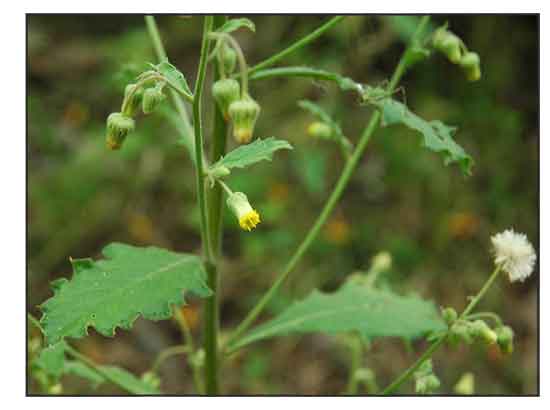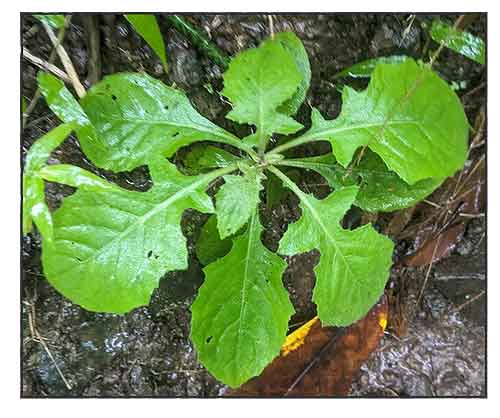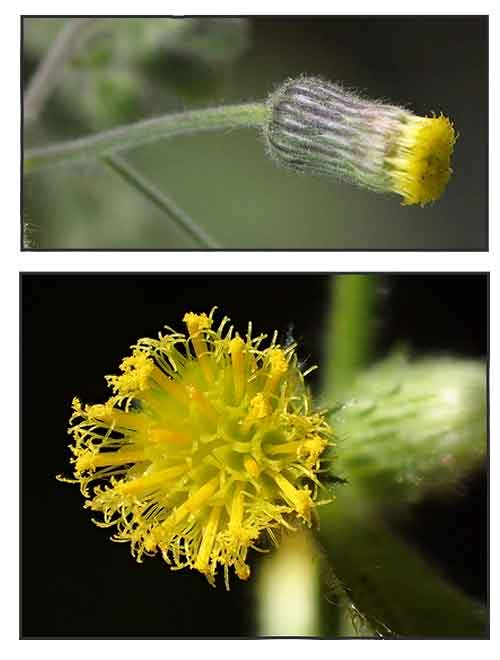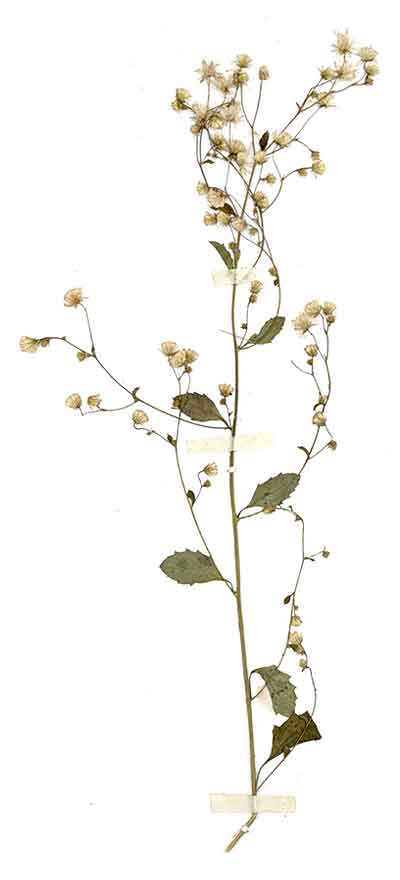 Gen info Gen info
- Blumea is a genus of flowering plants of the family Asteraceae. Plants in the genus are mostly relatively all weeds. Some are ruderal (a plant species first to colonize disturbed lands) species. A few of the species were formerly in the genus Conyza. (10)
- Etymology: The genus name Blumea honors Carl Ludwig Blume (1796-1862), a German-Dutch botanist who made extensive studies of the flora of southern Asia. The specific epithet laciniata derives from Latin laciniatus, meaning "jagged, torn, or slashed", referring to the deeply cut, fringed, or incised foliage.
Botany
• Sow-Thistle Blumea is a foul-smelling herb 20-180 cm tall from a taproot; stems erect to rising up, usually branched from the base, hairless to hairy. Leaves are inverted-lanceshaped, obovate to elliptic in outline, sometimes fiddle-shaped, 4.5-36.5 cm long, 0.8-21 cm wide, the lower ones pinnately lobed, sometimes with a large at branch-ends lobe, becoming progressively less lobed above, margins irregularly toothed, the lower ones stalked, leaf-stalks 1-6 cm long, stalkless above. Flower-heads are borne at branch-ends, in large, open panicles. Involucral bracts are often purple-tinged, reflexed at maturity, 1-8 mm long, hairy; receptacle sparsely hairy. Florets are yellow, those of perfect florets 5-lobed, 4-5 mm long, those of marginal pistillate florets 2-3-lobed, 3.5-4.5 mm long. Achenes are brown, ribbed, about 4 mm long. (2)
 • Malodorous herbs 2-18 dm tall from a taproot; stems erect to ascending, usually branched from the base, glabrate to pilose.  Leaves oblanceolate, obovate to elliptic in outline, sometimes lyrate, 4.5-36.5 cm long, 0.8-21 cm wide, the lower ones pinnately lobed, sometimes with a large terminal lobe, becoming progressively less lobed above, margins irregularly dentate, the lower ones petiolate, petioles 1-6 cm long, sessile above.  Heads in large, terminal, open panicles; involucral bracts often purple-tinged, reflexed at maturity, 1-8 mm long, pilose; receptacle sparsely pilose; corollas yellow, those of perfect florets 5-lobed, 4-5 mm long, those of marginal pistillate florets 2-3-lobed, 3.5-4.5 mm long.  Achenes brown, ribbed, ca. 4 mm long" (Wagner et al., 1999; p. 283). (PIER) • Malodorous herbs 2-18 dm tall from a taproot; stems erect to ascending, usually branched from the base, glabrate to pilose.  Leaves oblanceolate, obovate to elliptic in outline, sometimes lyrate, 4.5-36.5 cm long, 0.8-21 cm wide, the lower ones pinnately lobed, sometimes with a large terminal lobe, becoming progressively less lobed above, margins irregularly dentate, the lower ones petiolate, petioles 1-6 cm long, sessile above.  Heads in large, terminal, open panicles; involucral bracts often purple-tinged, reflexed at maturity, 1-8 mm long, pilose; receptacle sparsely pilose; corollas yellow, those of perfect florets 5-lobed, 4-5 mm long, those of marginal pistillate florets 2-3-lobed, 3.5-4.5 mm long.  Achenes brown, ribbed, ca. 4 mm long" (Wagner et al., 1999; p. 283). (PIER)
Distribution
- Native to the
Philippines. (1) (3)
- In old clearings, along roadsides and in waste places up to c. 1200 m.
- Also native to Andaman Is., Assam, Bangladesh, Borneo, Cambodia, Caroline Is., China South-Central, China Southeast, East Himalaya, Hainan, India, Jawa, Laos, Lesser Sunda Is., Malaya, Maldives, Marianas, Myanmar, Nansei-shoto, Nepal, New Caledonia, New Guinea, Nicobar Is., Solomon Is., Sri Lanka, Sulawesi, Taiwan, Thailand, Vanuatu, Vietnam, West Himalaya. (1)
 Constituents Constituents
- Study essential oil was rich in thymohydroquinone dimethyl ether (29.4%), (E)-β-caryophyllene (19.7%), α-pinene (8.8%), germacrene D (7.8%), and α-humulene (4.3%). (see study below) (5)
- Phytochemical study showed total phenolic content in various organs in the following order: old leaf > flower bud > young leaf > flower > young stem > old stem > root; and total flavonoids in the order: flower bud > old leaf > young leaf > flower > young stem > old stem > root.
Phenolic compounds identified were 3,4-dihydroxybenzoic acid, caffeic acid, vanillic acid, p-coumaric acid, syringic acid, rosmarinic acid, trans-cinnamic acid, catechin, catechol, (-) epicatechin, rutin, quercetin, myricetin, and kaempferol. (see study below) (8)
- Study of ethyl acetate fraction isolated and identified five compounds: protocatechuic acid (1), chrysoeriol (2), apigenin (3), 4-hydroxy-3,5-dimethoxbenzoic acid (4), scopolet (5). (13)
Properties
- Studies suggested mosquito larvicidal, antibacterial, antioxidant, antifungal, lipase inhibitory, antiadipogenic, anti-Alzheimer's, cholinesterase inhibitory, anti-ageing properties.
Parts used
Leaves, stems, essential oil.
Uses
Edibility
- No info found on edibility.
Folkloric
- No reported folkloric medicinal use in the Philippines. (2)
- In Vietnam, leaves and stems used for treatment of boils, detoxification, and to stop bleeding. Leaves used for treatment of flu, rheumatism, bone pain, and injury-induced pain and swelling. (4)
 Studies Studies
• Mosquito Larvicidal / Essential Oil: Study evaluated five plant species in Vietnam i.e., Blumea sinuata, B. lacera, Emilia sonchifolia, Parthenium hysterophorus, and Sphaeranthus africanus for essential oil with larvicidal activity against Aedes aegypti and Ae. albopictus. One of the two most active larvicidal essential oils was B. sinuata, which was rich in thymohydroquinone dimethyl ether (29.4%), (E)-β-caryophyllene (19.7%), α-pinene (8.8%), germacrene D (7.8%), and α-humulene (4.3%), (24-h LC50 23.4 and 29.1 μg/mL) on Ae. aegypti and Ae. albopictus, respectively. The EO was non toxic to non-target water bug, Diplonychus rusticus. (5)
• Silver Nanoparticles / Antibacterial / Antifungal / Antioxidant: Study reports on the eco-friendly synthesis of non-toxic silver nanoparticles using B. sinuata extract. On antibacterial activity by agar-well diffusion method at dose of 400 µg concentration, the AgNPs showed maximum zones of inhibition of 20.66 mm and 20.33 mm against phytopathogenic bacteria E. carotovora and R. solanacearum respectively. The NPs showed remarkable antifungal activity against phytopathogenic fungi Alternaria alternata, Aspergillus niger, A. flavus, and Fusarium oxysporum. Antioxidant activity by DPPH showed free radical scavenging activity of 25.85% at 80 µg/mL, and 40.28% at 80 µg/mL by ABTS. Strong reduction and capping potential were attributed to high amounts of some phytoconstituents. (6)
• Larvicidal Against Ae. aegypti / Leaves: Study evaluated plant leaf extracts (Blumea sinuate, Ageratum conyzoides, Syndrella nodiflora, Tridax procumbens) for activity against 4th instar larvae of Aedes aegypti. B. sinuata petroleum ether extract showed LC50 and LC90 of 5.02 and 8.12 at 24 and 48 hrs respectively, and chloroform extract 15.94 and 4.11, and 32.46 and 6.34 at 24 and 48 hours respectively. (LC50 is concentration that kills 50% and LC90 is concentration that kills 90% of target.) (7)
• Antidiabetic / Lipase Inhibitory / Antioxidant / Anti-Alzheimer's Disease: Study evaluated B. lanciniata for potential against diabetes, and and antioxidant activity. Solvent extracts showed strong antioxidant activity and varying inhibition of enzymes tested, with strong inhibitory activity against α-amylase, α-glucosidase, and lipase. Solvent extracts significant suppressed blood glucose levels in mice with induced diabetes. For lipase inhibition activity, molecular docking studies were done. Quercetin showed highest binding affinity with -9.80 kcal/mol against lipase active site. Various other studies have found that catechin, (-) epicatechin, rutin, myricetin, quercetin, kaempferol, and rosmarinic acid have pancreatic lipase inhibitory and anti-adipogenic activity, which support the lipase inhibitor potential of Blumea lanciniata. Extract also showed potential therapeutic potential for management of Alzheimer's disease via dual simultaneous inhibition of AChE and BChE by a possible synergistic effect of phenolic compounds. (see constituents above) (8)
• Aroma Volatile Compounds / Antimicrobial: Study characterized the aroma volatiles of two wild Asteraceae, Blumea laciniata and B. axillaris. The essential oil was extracted by steam distillation and fractionation by organic solvents. GC-MS characterized the volatile oils and molecular docking determined the antimicrobial activity. Only the ethyl acetate fractions showed MIC at X/4th dilution against Aspergillus parasiticus, Baciillus cereus, and Escherichia coli. The two species showed distinct EO profiles with four comparatively small ligans. Molecular docking study identified the most active compound as [1H-Indole-2,3-dione, 1-(tert-butyldimethyl)] along with Methoxy-phenyl- Oxime, Phthalic acid butyl hexyl ester and Thymol phthalein of the extracted essential oil. Results suggest the EO compounds, alone or in combination, can be applied for topical antimicrobial treatment against bacterial and mould species. (9)
• Antioxidant / Protection on HeLa Cells against H2O2: Study evaluated the chemical components of B. laciniata and the antioxidant ability on scavenging radicals and protection on HeLa cells against H2O2. Chlorogenic acid, isoorientin, rutin, luteolin-4'-O-glucosde were identified. Results showed antioxidant ability associated with the presence of polyphenols via response surface method. Extract also showed strong antioxidant activity on clearing DPPH and ABTS free radicals with lower EC50. The extract showed no toxicity on Hela cells and could protect cells from H2O2 induced damage by sharply reducing excessive reactive oygen species, improving mitochondrial membrane potential and decreasing generation of cell apoptosis. (11)
• Anti-Ageing / Antioxidant: Study has confirmed a polyphenol extract containing chlorogenic acid, rutin, and luteolin-4-O-glycoside showed strong antioxidant ability. Study further evaluated the antioxidant and anti-ageing ability of B. laciniata extract (EBL) in vivo using Caenorhabditis elegans. Results showed EBL enhanced survival of C. elegans under thermal stress by 12.62% and sharply reduced ROS as well as malonaldehyde level. EBL increased activities of antioxidant enzymes such as catalase and superoxide dismutase, promoted DAF-16, a transcription factor, into the nucleus. EBL extended the lifespan of C. elegans by 17.39%, showing an anti-ageing effect. Different mutants indicated that the insulin/IGF-1 signaling pathway participated in the antioxidant and anti-ageing effects of EBL on C. elegans. (12)
Availability
- Wild-crafted.
|

![]()





 Constituents
Constituents Studies
Studies 